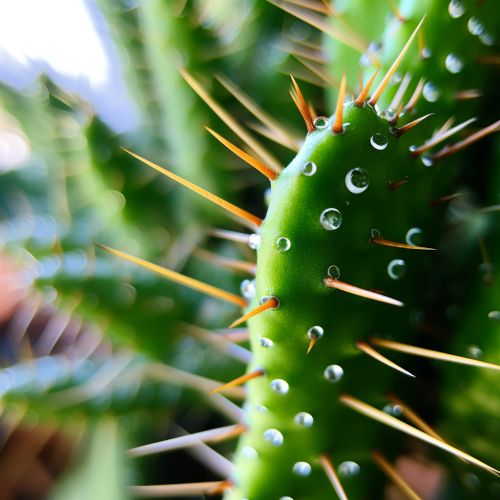Thorns, spines, and prickles
Introduction
Thorns, spines, and prickles are all types of sharp, pointed structures found on various plants. These structures serve as a physical deterrent to herbivores, preventing them from eating the plant. While they may appear similar to the untrained eye, thorns, spines, and prickles are distinct structures that develop from different parts of the plant. This article will delve into the detailed characteristics, formation, and functions of these structures, as well as their role in plant defense mechanisms.
Definitions and Differences
Thorns, spines, and prickles are all modifications of plant organs, but they differ in their origin and development.
Thorns
Thorns are derived from shoots, which are the above-ground parts of a plant including stems, branches, and leaves. They are typically large, woody, and branched structures that can be found at the nodes of the plant. Examples of plants with thorns include the Hawthorn tree and the Honey Locust tree.
Spines
Spines are derived from leaves, specifically from leaf tissues or stipules, which are small leaf-like appendages found at the base of the leaf stalk. Spines are generally smaller than thorns and are unbranched. Cacti are well-known for their spines, which are modified leaves.
Prickles
Prickles are derived from the epidermis, the outermost layer of the plant, and can be found anywhere on the plant. They are typically small, sharp outgrowths that extend from the surface of the plant. Roses are a common example of plants with prickles.


Formation and Development
The formation and development of thorns, spines, and prickles involve various plant growth processes and are influenced by both genetic and environmental factors.
Thorns
The formation of thorns involves the modification of the plant's shoots. This process is typically triggered by certain environmental conditions, such as grazing pressure from herbivores. The plant responds to this pressure by producing thorns to deter the herbivores.
Spines
Spines are formed through the modification of leaves or stipules. In many cases, the development of spines is a response to arid conditions. For example, in cacti, the leaves have evolved into spines to reduce water loss through transpiration.
Prickles
Prickles are formed from the plant's epidermis and can develop in response to various environmental stimuli. The exact mechanisms of prickle formation are not fully understood, but it is thought to involve changes in the plant's hormone levels.
Functions
Thorns, spines, and prickles serve several functions in plants, primarily related to defense and survival.
Defense Against Herbivores
The primary function of thorns, spines, and prickles is to deter herbivores. These sharp structures can cause physical injury to the herbivore, discouraging it from eating the plant. This is particularly important for plants in areas with high herbivore pressure.
Water Conservation
In arid environments, spines can play a crucial role in water conservation. By replacing leaves, which lose water through transpiration, spines help to reduce water loss and enable the plant to survive in dry conditions.
Climbing Support
In some plants, thorns can serve as a means of support, allowing the plant to climb over other plants or structures. This can help the plant to reach sunlight in dense vegetation.
Role in Plant Defense Mechanisms
Thorns, spines, and prickles are part of a plant's physical defense mechanisms, which also include tough leaves and bark, and chemical defenses such as toxins and deterrents. These defenses work together to protect the plant from herbivores and other threats.
